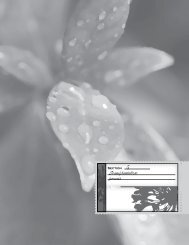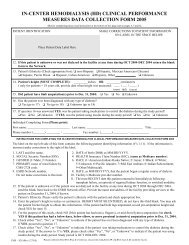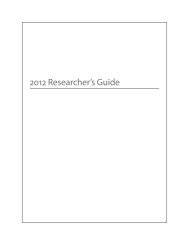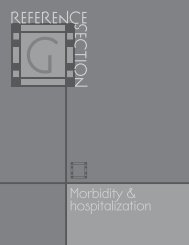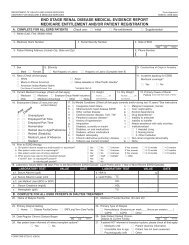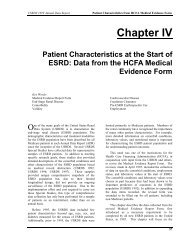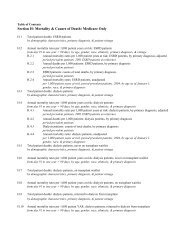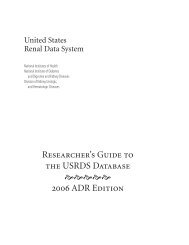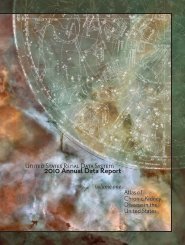2009 ADR v2 Atlas of ESRD - United States Renal Data System
2009 ADR v2 Atlas of ESRD - United States Renal Data System
2009 ADR v2 Atlas of ESRD - United States Renal Data System
You also want an ePaper? Increase the reach of your titles
YUMPU automatically turns print PDFs into web optimized ePapers that Google loves.
5<br />
App B<br />
pg 390<br />
b aii<br />
USRDS products<br />
& services<br />
Reports & guides<br />
Annual <strong>Data</strong> Reports Available from the National Kidney and Urologic<br />
Disease Information Clearinghouse, 3 Information Way, Bethesda, MD<br />
20892-3560; 301.654.4415, nkudic@info.niddk.nih.gov. <strong>ADR</strong> material is<br />
also published in the American Journal <strong>of</strong> Kidney Diseases.<br />
Annual <strong>Data</strong> Report CD Contains the text and graphics <strong>of</strong> the <strong>ADR</strong>,<br />
data tables, PowerPoint slides, and the Researcher’s Guide.<br />
Researcher’s Guide to the USRDS database<br />
Provides a detailed description <strong>of</strong> the USRDS database and <strong>of</strong> the USRDS<br />
Standard Analysis Files; the basic reference for researchers who use<br />
USRDS data fi les.<br />
www.usrds.org<br />
Contains PDF fi les <strong>of</strong> the chapters, reference tables, and the Researcher’s<br />
Guide; PowerPoint slides <strong>of</strong> atlas fi gures and USRDS conference presentations;<br />
Excel fi les <strong>of</strong> the data tables; notices regarding current news and<br />
analyses; links to related Internet sites; and email addresses for contacting<br />
the USRDS.<br />
RenDER<br />
The USRDS <strong>Renal</strong> <strong>Data</strong> Extraction and Referencing (RenDER) <strong>System</strong> is a<br />
querying application that allows users to create data tables and interactive<br />
maps . It can be accessed at www.usrds.org/odr/xrender_home.asp<br />
following a short registration; a tutorial is also available on this site to<br />
help new users.<br />
Requests for data<br />
<strong>Data</strong> requests: two-hour Questions and data requests that are not<br />
answered directly by the <strong>ADR</strong> can be addressed to the Coordinating<br />
Center; those that require less than two hours <strong>of</strong> staff time to fulfi ll will<br />
be processed without charge.<br />
<strong>Data</strong> requests: more than two hours Questions and data requests that<br />
require over two hours <strong>of</strong> staff time must be submitted in writing and<br />
approved by the NIDDK Project Offi cer. Fulfi llment <strong>of</strong> these requests<br />
is subject to staff availability, and costs are assessed on a case-by-case<br />
basis.<br />
Standard Analysis Files SAFs provide patient-specifi c data from<br />
the USRDS to support <strong>ESRD</strong> research. A standard price list has been<br />
established for the fi les (Table b.c), and users must sign a <strong>Data</strong> Release<br />
Agreement with the NIDDK.<br />
Custom data fi les Custom fi les can be created by the Coordinating Center<br />
for projects requiring data other than those provided in the Standard<br />
Analysis Files. An hourly rate <strong>of</strong> $119.57 will be assessed for time spent<br />
on the request, and users must sign a data release agreement with the<br />
NIDDK.<br />
Publications & presentations<br />
Most USRDS research studies result in published papers or presentations<br />
at national meetings. Figures from abstracts and presentations can<br />
be found on the website, while published abstracts and papers can be<br />
found in the relevant journals.<br />
Contact information<br />
<strong>Data</strong> requests & publication orders USRDS Coordinating Center<br />
914 South 8th Street, Suite S-206<br />
Minneapolis, MN 55404<br />
612.347.7776 or 1.888.99USRDS<br />
Fax 612.347.5878<br />
usrds@usrds.org<br />
<strong>Data</strong> fi le contacts Shu-Cheng Chen, MS; schen@usrds.org<br />
Beth Forrest, BBA; bforrest@usrds.org<br />
b bii<br />
Contents <strong>of</strong> the USRDS Core<br />
Standard Analysis CD-ROM<br />
File name unit <strong>of</strong> observation & uses • This two-CD set is needed in<br />
order to use any <strong>of</strong> the other Standard Analysis Files.<br />
Patient one record for each <strong>ESRD</strong> patient • Incidence, prevalence, patient<br />
survival. Most other fi les will need to be linked to this fi le using the<br />
encrypted patient ID.<br />
Residence for each patient, one record for each period in a diff erent<br />
residence • Regional analyses.<br />
Treatment History one record for each period a patient is on one<br />
modality • Modality distribution and treatment patterns.<br />
Payor History one record for each period a patient is covered by one<br />
payor; each patient can have many records • The impact <strong>of</strong> insurance<br />
payors on clinical outcomes.<br />
Medical Evidence one record for each 2728 form fi led (1995 version) •<br />
<strong>ESRD</strong> fi rst service date, initial treatment modality, comorbid conditions,<br />
patient status at start <strong>of</strong> <strong>ESRD</strong>.<br />
Transplant one record for each transplant event; patients can have<br />
multiple events • Transplant and transplant outcome analyses.<br />
Transplant Wait List one or more records for each patient ever on<br />
list • Comparison <strong>of</strong> transplanted patients to dialysis patients who are<br />
transplant candidates. Patient selection to wait list.<br />
Dialysis Morbidity and Mortality (DMMS; Special Study)<br />
Wave 1: 5,670 patients; Wave 2: 4,024 patients; Wave 3: 11,142 patients<br />
Comorbid conditions, adequacy <strong>of</strong> dialysis, dialysis prescription and<br />
other treatment parameters, laboratory test values, nutrition, vascular<br />
access.<br />
Case Mix Adequacy (Special Study) 7,096 patients • Comorbid conditions,<br />
adequacy <strong>of</strong> dialysis, dialysis prescription and other treatment<br />
parameters, laboratory values.<br />
Case Mix Severity (Special Study) 5,255 patients • Comorbid conditions,<br />
adequacy <strong>of</strong> dialysis, dialysis prescription and other treatment<br />
parameters, laboratory values.<br />
Pediatric Growth and Development (Special Study) 3,067<br />
patients • Growth, development, and other issues relating to pediatric<br />
<strong>ESRD</strong> patients.<br />
CAPD Peritonitis (Special Study) 3,385 patients • CAPD and peritonitis.<br />
Facility one record for each year facility has operated • Merge with<br />
the treatment history, transplant, or annual summary SAFs for analyses<br />
involving provider characteristics by encrypted ID.<br />
Facility Cost Reports one record per facility per year (1989–1995) •<br />
Costs and staffi ng <strong>of</strong> dialysis facilities.<br />
Dialyzers information on dialyzer characteristics; to be matched to<br />
patient dialyzer information in other fi les on CD • Relation <strong>of</strong> dialyzer<br />
characteristics to patient outcomes.<br />
CLMCODES one record for each diagnosis, procedure, or HCPCS code<br />
appearing in claims fi les • Frequency <strong>of</strong> occurrence <strong>of</strong> each code. A<br />
starting point for analyses that will use diagnosis and procedure codes.<br />
Formats.SC2 all USRDS-defi ned SAS formats used by SAFs • Format<br />
library used to format values <strong>of</strong> categorical variables.



